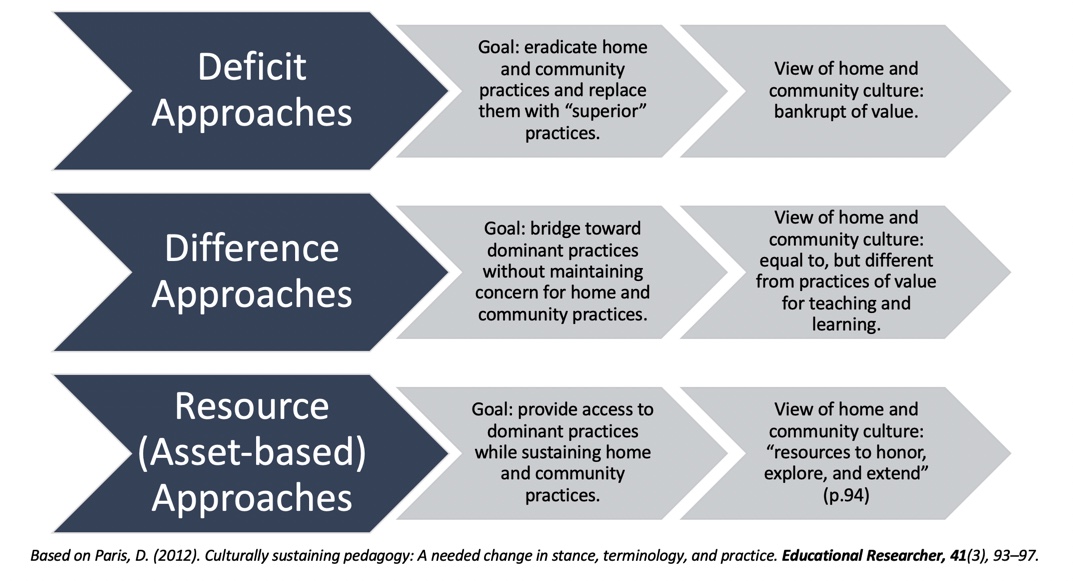1 Asset-Based Pedagogies
Introduction
We teach what we value. – Gloria Ladson-Billings
This part of Module 1 is an introduction to the concept of Asset-Based Pedagogies. Asset-Based Pedagogies see the languages, experiences, communities, and cultures of students as resources to be honoured rather than deficits to be overcome. The principles of Culturally Relevant Pedagogy (CRP) and Culturally Sustaining Pedagogy (CSP) will be introduced below. These principles will inform all of the modules in this micro-credential, so we encourage you to complete this portion first. While the information below provides a brief overview of CRP and CSP, you can dive deeper by consulting the materials in the “Additional Resources” section.
Culturally Relevant and Culturally Sustaining Pedagogy
Historically, schools have seen the home cultures of students of colour and English-language learners as deficits to be overcome or resources to be treated as a bridge to preferable, dominant practices. Current pedagogies, including culturally sustaining and revitalizing pedagogies, take an asset-based approach by viewing students’ home and community cultural practices as resources “to honour, explore, and extend” (Paris 2012, p. 94). In this module, we will explore this asset-based approach to students’ home and community cultural practices. The most well-known asset-based approach is culturally relevant pedagogy (CRP).
Culturally Relevant Pedagogy
Culturally Relevant Pedagogy comes from the work of Dr. Gloria Ladson-Billings. She is a pedagogical theorist and teacher educator whose research focuses on culturally relevant pedagogy and critical race theory.
CRP’s goals:
- Students achieve academically.
- Students demonstrate cultural competence (maintaining their own heritage and community practices while gaining access to dominant practices).
- Students understand and critique the existing social order. (Ladson-Billings, 1994)
The graphic below compares deficit, difference, and asset-based approaches:
Culturally Sustaining Pedagogy
Culturally sustaining pedagogy was coined by Dr. Django Paris. CSP retains the goals of culturally relevant pedagogy but goes a step farther. In addition to ensuring racialized students maintain their own heritage and community practices while gaining access to dominant practices, culturally sustaining pedagogy engages with students’ youth culture practices and recognizes that youth are producers of culture as well as consumers. Culturally relevant pedagogy sees racialized students’ heritage and community cultural practices as resources to honour and explore; culturally sustaining pedagogy sees them as resources to honour, explore, and extend.
To learn more about culturally sustaining pedagogy, listen to The Look and Feel of Culturally Responsive Instruction with Django Paris. You can also follow along with or read Django-Paris-Podcast-Transcript[PDF].
 Knowledge Check
Knowledge Check
As you read or listen to the podcast, think about the questions below and jot down your answers. When you’re finished click on each question to see a possible answer.
 Key Takeaways
Key Takeaways
- Culture is “dynamic, shifting, and ever-changing” (Paris, 2012, p. 95).
- Take care not to essentialize students’ cultures or be overdeterministic in linking cultural practices to racial and ethnic groups.
- Value both traditional, heritage practices and current, community practices.
- Invite students to critique cultural texts and practices by considering how they can promote inequity or be exclusionary.
- “…learners can be sources and resources of knowledge and skills…” (Ladson-Billings, 2014, p. 79)
- The key question we must keep in mind as we implement culturally sustaining pedagogy is, “What are we seeking to sustain?”
Ways to incorporate culturally sustaining pedagogy into your instruction
Work with students as co-creators of curriculum and programming:
- Invite students to participate in the selection of materials for your classroom.
- Have students choose from a menu of different products to use to demonstrate how they engage with instructional or library resources.
- Have students create their own questions to ask as writing prompts.
- Invite students to share their own stories.
- Include students’ out-of-school experiences as reference points in class discussions.
Bring students’ culture into the curriculum and library:
- Use popular media (movies, comics, video games, music, more) and non-traditional texts (street art, tattoos, more) that students identify as personally resonant as texts to engage with and critique.
- Use these same media as ways for students to demonstrate understanding.
Connect with the community:
- Bring in guest speakers. It is critical that guest speakers reflect the racial diversity of your community. Racialized students should have opportunities to hear from community leaders who look like them and share their culture and some of their experiences.
 Apply
Apply
- Brainstorm what you can do in your library or classroom to incorporate culturally sustaining pedagogy into your instruction.
- Select one change you want to make in your classroom to enact culturally sustaining pedagogy. Make a plan, then implement it.
This part of Module 1 was adapted from Hughes-Hassell, S., Rawson, C. H., & Hirsh, K. (2019). Culturally Sustaining Pedagogy. In Hughes-Hassell, S., Rawson, C. H., & Hirsh, K. (Eds.), Project READY: Reimagining equity and access to diverse youth [online curriculum]. Retrieved from https://ready.web.unc.edu/section-2-transforming-practice/module-17/.

